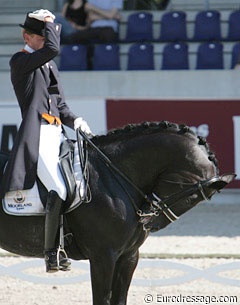
The German Equestrian Federation took an official stand against rollkur or hyperflexion in the following statement:
Every training method, be it for the long-term training at home or in the warm-up area of horse shows, must be in line with animal welfare and the fundamental principles of the equestrian federations. These principles are laid down in the national and international rule books, in the official instruction handbook (Richtlinien) of the German Equestrian Federation, but also in the FEI Dressage Handbook.
The first principles that are quoted below cannot be taken exclusively for judging dressage competitions. These stipulations are derived from the horse’s nature and must therefore be adhered to in every training session and in warm-up areas in all disciplines:
“Object and General Principles of Dressage
The object of dressage is the development of the horse into a happy athlete through harmonious education. As a result, it makes the horse calm, supple, loose and flexible, but also confident, attentive and keen, thus achieving perfect understanding with the rider.
These qualities are revealed by:
- The freedom and regularity of the paces.
- The harmony, lightness and ease of the movements.
- The lightness of the forehand and the engagement of the hindquarters, originating from a lively impulsion.
- The acceptance of the bridle, with submissiveness / throughness (Durchlässigkeit) without any tension or resistance.” …
In all disciplines, observing the suppleness of a horse plays a key role in training, warming-up for the competition and in the competition itself.
“Suppleness:
Indications of suppleness are:
- A content happy expression – freedom from anxiety.
- The elasticity of the steps – the ability to stretch and contract the musculature smoothly and fluently.
- A quiet mouth gently chewing the bit with an elastic contact.
- A swinging back with the tail carried in a relaxed manner.
- Soft and rhythmical breathing, showing that the horse is mentally and physically relaxed.”
This suppleness cannot be completely achieved at all times. But every training with horses that clearly contradicts the above-mentioned criteria must be declined!
Therefore the riding method which is called “hyperflexion” is characterized by an extremely deep flexion of the horse’s head and neck and the rider’s reins forcing the horse to take its mouth clearly towards its chest and shoulder joint - is clearly unacceptable.
In the internationally accepted system, priority is not just given to the result in the dressage arena, in the jumping course or in the cross-country. The responsibility of the federations and all persons involved in the sense of a “happy athlete” also covers the training and warm-up for the competition.
In order to duly respect the internationally recognised education and training principles of classical riding instruction and of animal welfare, from our point of view the statements below must basically and essentially be observed. Every horseman knows that momentary deviations are possible in certain situations. But these should be avoided as far as possible.
- Even in an intense training session, the harmony in the movement of horse and rider may not be lost.
- The mounted horse must be able to balance itself unobstructed, not cramped. To that end it does need a certain freedom to move, particularly in its neck.
- A forced posture where the rider does not work with the horse any more, but against it, must not be accepted. A strong bending or compression of the s-formed cervical spine is detrimental to the elasticity and flexibility of the whole spine across the back to the tail. Any kind of extreme overexpansion (in all directions) is therefore unacceptable.
- A rude action of the rider, particularly if it can be observed sustainably, must not be accepted.
- A total mental servility of the horse (in a position of head and neck that considerably limits the horse’s visual field) must be declined.
Temporary moments in training with deeper (not significantly tighter) positioning of head and neck with a recognisable confidence of the horse to the rider’s hand do not contradict the above-mentioned principles. However, the aim of dressage work is a horse that balances and carries itself!
In order to adequately judge a training situation in the warm-up area, the competence of Stewards and Judges is particularly important. Besides the length of time, it is significant to assess the situation in a bigger picture and the intensity of the rider’s action.
Translation courtesy: St. Georg
Photo © Astrid Appels
Related Links
Open Letter by Klaus Balkenhol on FEI Round Table Conference on Rollkur
Round Table Conference about Rollkur at FEI Headquarters